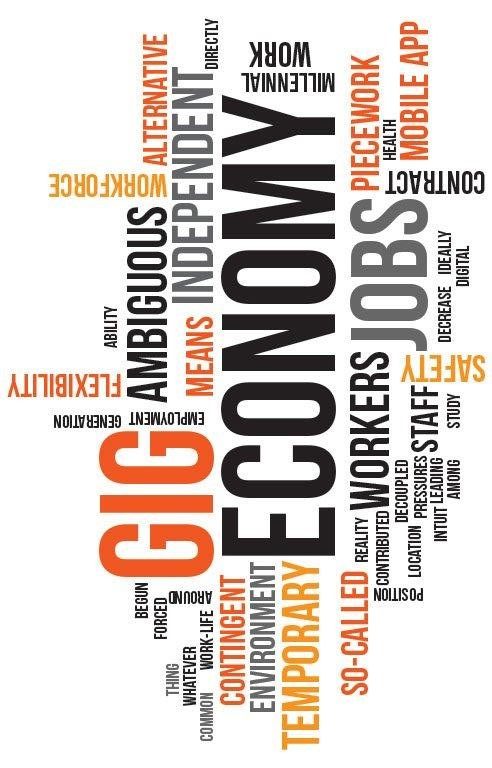Finance
THE GIG ECONOMY CREATES A PERMANENT UNDERCLASS

The estimated reading time for this post is 125 seconds
Continue Reading
Trending Now :
Published
6 years agoon

The estimated reading time for this post is 125 seconds
Everybody seems to have a gig economy job these days, but they provide none of the employee benefits that often help employees move up and stay in the middle class. The gig economy, which consists of a collection of applications aka the “App,” does not consider or see those who work for them as employees. Established companies like Uber, Lyft, Task Rabbit, Airbnb, Turo, and many more classify their employees as independent contractors.
Unlike traditional corporations that often value those who work for them as human resources, the gig economy has humans who serve as middlemen between them and their clients. Because the gig economy does not consider those with gig economy jobs part of their resources, they are less protective of them. The working-class individuals, who work in the gig economy full-time, have no healthcare, paid holidays, vacations, sick time off, or any other standard employee benefits. They don’t get any benefits, nor do they make a living wage.
Those with gig economy jobs cannot make their way up to the middle class even if they work 80 hours a week. Many of them work for more than one gig jobs, but they still can’t make ends meet. The benefits and resources such as healthcare, sick leave, career development, and 401 (k) often provided by traditional corporations substitute for dynamic scheduling, irregular hours, and unsteady workloads.
The gig economy does not believe that the working-class individuals, who serve their clients, are human resources. They don’t protect them and provide them with an option to move up to the next socioeconomic rung. However, Uber, Lyft, and Amazon recognize that those who work for them are humans–not robots. It’s progress considering are little they value them.
Senior Accounting & Finance Professional|Lifehacker|Amateur Oenophile
Mortgage rates are near 2025 lows. Should you buy, refi, or wait for another Fed cut? See the numbers and decide what fits your budget.
Trump Accounts promise $1,000 starter balances for kids, but are they worth your limited dollars? See who qualifies and how to use them.
Mortgage rates are near 2025 lows. Should you buy, refi, or wait for another Fed cut? See the numbers and decide what fits your budget.
By Article Posted by Staff Contributor
Trump Accounts promise $1,000 starter balances for kids, but are they worth your limited dollars? See who qualifies and how to use them.
By Article Posted by Staff Contributor
Don’t let your FSA money vanish. Learn the real difference between FSAs and HSAs and how to choose the right one for your middle-class budget.
By Article Posted by Staff Contributor
Will Trump’s higher $40,000 SALT cap actually help your middle-class family, or just coastal high earners? Learn what really changes for you.
By Article Posted by Staff Contributor
Florida property tax changes explained. See how HJR 201–215 could affect you, your rent, and local services before you vote.
By FMC Editorial Team
Trailing interest can quietly cost you thousands in credit card charges—learn how to spot it, stop it, and keep more money in your pocket.
By Article Posted by Staff Contributor
Paying too much for your car? Learn when refinancing your auto loan saves money and how to avoid costly refi traps.
By Article Posted by Staff Contributor
Worried you owe more than your car is worth? Learn how to avoid an upside-down car loan and protect your middle-class budget.
By Article Posted by Staff Contributor
Think you just have a car payment? Learn your true total car cost and how to keep it from wrecking your middle-class budget. Start fixing it...
By Article Posted by Staff Contributor
Heat, lights, and higher rates: decode your December energy bill and make smart cuts that lower costs without killing the holiday vibe.
By Article Posted by Staff Contributor
Mortgage rates are near 2025 lows. Should you buy, refi, or wait for another Fed...
Trump Accounts promise $1,000 starter balances for kids, but are they worth your limited dollars?...
Don’t let your FSA money vanish. Learn the real difference between FSAs and HSAs and...
Pingback: America Is Still a Middle-Class Country - FMC
Pingback: The Fight for 15 Is Our Fight Too - FMC Politics - %
Pingback: 5 WAYS TO SAVE MONEY IF YOU ARE BROKE - FMC
Pingback: Debt You Can't Discharge Through Bankruptcy - Personal Finance FMC
Pingback: Uber and Lyft Can Keep Taking Advantage of Their Rideshare Drivers, for Now - Gig Economy
Pingback: What Matters to Middle-Class Voters - FMC